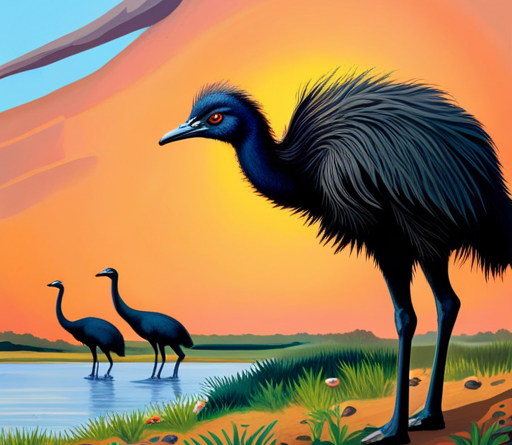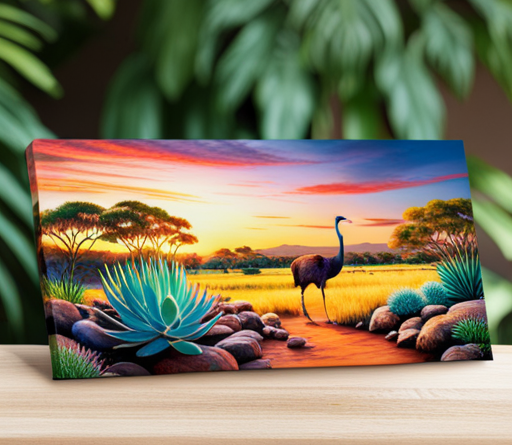
Did you know that emus, those fascinating flightless birds, are actually the second-tallest birds in the world, standing at an impressive height of up to 6 feet?
Come, let’s journey together through the captivating history of emus and uncover their remarkable story. From ancient origins and indigenous cultural significance to European encounters and settler agriculture, these intriguing creatures have left their mark throughout history.
Explore their role in Aboriginal dreamtime stories, their value as a source of food and resources, and even their contribution to the fashion trade through their exquisite feathers.
Today, as conservation efforts continue, emus remain an important part of the Australian landscape. So, let’s delve into the captivating history of these magnificent birds, one fascinating chapter at a time.
Key Takeaways
- Emus have a long history and cultural significance, being featured in various forms of media and playing a central role in Aboriginal traditions and folklore.
- Emus are portrayed as powerful spiritual beings in Aboriginal Dreamtime stories, carrying the spirits of ancestors and emphasizing the importance of living in harmony with nature.
- Emus provide food and resources for Aboriginal communities, with their lean meat, oil, feathers, and eggs being utilized for sustenance, medicinal purposes, and traditional art.
- European encounters with emus during exploration and settlement highlighted their unique characteristics, adaptability, and the challenges and benefits they posed to agriculture.
Ancient Origins
If you want to learn about the ancient origins of emus, you might be surprised to find out that these flightless birds have been roaming the earth for thousands of years. Emus have a long and storied history, with their roots dating back to prehistoric times. These fascinating creatures have managed to adapt and survive in various environments throughout history, making them an intriguing subject of study.
In modern society, emus have become a symbol of resilience and strength. Their ability to withstand harsh conditions and thrive in the wild has made them a respected creature in popular culture. Emus have been featured in various forms of media, such as books, movies, and even video games, further cementing their place in the collective consciousness.
Emus have also had an impact on the Australian culture, where they’re native. They hold a significant place in the traditions and folklore of the Aboriginal people, who’ve long regarded them with reverence. Emus have been depicted in ancient rock art, showcasing their importance in the spiritual beliefs of the indigenous communities.
Indigenous Cultural Significance
Emus’ indigenous cultural significance is deeply rooted in the traditions and folklore of the Aboriginal people, who hold them in high regard. These majestic birds play a central role in various indigenous rituals and ceremonies, symbolizing important aspects of Aboriginal culture. Emus are often depicted in artistic representations, such as paintings, carvings, and sculptures, which further emphasize their cultural significance.
In indigenous rituals, emus are seen as spiritual beings that connect the physical and spiritual realms. They’re believed to possess unique qualities that represent resilience, adaptability, and strength. Aboriginal people incorporate the emu’s characteristics into their rituals to invoke these qualities and seek guidance, protection, and success in various aspects of life.
Furthermore, emus are frequently featured in artistic representations, reflecting their cultural importance. These depictions can be found in traditional art forms, like dot paintings and rock engravings, as well as contemporary artworks. The intricate patterns and vibrant colors used in these representations often convey deeper meanings related to the emu’s role in the Aboriginal culture.
As we delve deeper into the significance of emus in Aboriginal culture, it becomes evident that they also hold a prominent position in Aboriginal dreamtime stories. These stories, passed down through generations, provide a rich narrative that explores the emu’s role in the creation of the world and its ongoing presence in the spiritual realm.
Emus in Aboriginal Dreamtime Stories
Continuing from the previous subtopic on indigenous cultural significance, let’s now delve into the realm of Aboriginal Dreamtime stories and explore the role of emus.
In Aboriginal lore, emus hold a significant place in the spiritual beliefs of the indigenous communities. These majestic creatures are often portrayed as powerful beings, embodying both physical and spiritual strength.
Emus feature prominently in Dreamtime stories, which are the traditional narratives of the Aboriginal people that explain the creation of the world and the laws that govern it. These stories are passed down through generations, serving as a way to connect with their ancestors and understand the natural world.
In many Dreamtime stories, emus are depicted as sacred creatures that possess great wisdom and knowledge. They’re often associated with important cultural teachings and lessons, symbolizing the importance of balance, resilience, and adaptability. Emus are believed to carry the spirits of the ancestors, acting as messengers between the human and spiritual realms.
Through these stories, Aboriginal communities honor the emu as a spiritual guide and protector. The emu’s presence in Dreamtime stories serves as a reminder of the profound connection between the Aboriginal people and the natural world, emphasizing the importance of respecting and living in harmony with nature.
Emus as a Source of Food and Resources
Emus have long been relied upon by Indigenous communities as a valuable source of food and resources. These majestic birds offer sustainable protein and a variety of other benefits that have sustained Aboriginal communities for centuries.
| Emus as Sustainable Protein | Emus as a Source of Natural Oils |
|---|---|
| Emu meat is lean and low in fat, making it a healthy and sustainable source of protein. It is rich in iron, vitamin B12, and omega-3 fatty acids, offering numerous health benefits. Aboriginal communities have traditionally hunted emus for their meat, using every part of the bird for sustenance. | Emu oil, extracted from the fat of the bird, has been used for centuries by Indigenous communities for its medicinal properties. It is known for its anti-inflammatory and moisturizing properties, and is used to treat skin conditions, wounds, and arthritis. Emu oil is also used in the production of cosmetics, soaps, and lotions. |
Emus have played a crucial role in providing sustenance and resources for Indigenous communities. Their meat offers a sustainable source of protein, while their fat provides valuable natural oils for medicinal and cosmetic purposes. The holistic use of emus demonstrates the deep knowledge and respect that Aboriginal communities have for these incredible birds.
European Encounters and Observations
Having been relied upon by Indigenous communities for centuries, emus attracted the attention of European explorers and settlers upon their arrival in Australia. The encounters between Europeans and emus were marked by a mix of curiosity, wonder, and a desire to understand the indigenous cultural significance of the emu.
European explorers, such as Captain James Cook, encountered emus during their voyages to Australia, noting their unique appearance and behavior.
Settlers, who arrived in Australia in the late 18th and early 19th centuries, observed the emus’ presence in the landscape and their interactions with Indigenous communities.
European observers were fascinated by the emus’ ability to adapt to different environments and their impressive running speed.
Some Europeans tried to hunt emus for their feathers, which were highly valued in Europe for fashion and ornamentation.
Europeans also sought to understand the emu’s spiritual significance in Indigenous cultures, recognizing the bird’s role in creation stories and ceremonies.
These European encounters and observations provide a glimpse into the early interactions between Europeans and emus in Australia. They highlight the cultural significance of emus to Indigenous communities and the fascination that Europeans had with these unique and resilient birds.
Emus in Early Australian Exploration
During the early exploration of Australia, you encountered emus and were captivated by their unique characteristics and behaviors. These encounters sparked interest among explorers, leading to early scientific studies on emus. Explorers observed the emu’s majestic appearance, with its tall stature and distinct feathers. They were fascinated by the emu’s ability to run at high speeds and its agility in navigating through the challenging terrain of the Australian outback.
Early scientific studies focused on understanding the emu’s anatomy, diet, and breeding habits. Explorers noted the emu’s strong legs and powerful beak, which allowed it to forage for food and defend itself against predators. They also observed the emu’s preference for vegetation, including grasses, fruits, and seeds. Explorers witnessed the emu’s intriguing courtship rituals, where male emus performed elaborate dances to attract females.
The significance of emus in early Australian exploration extended beyond scientific curiosity. The emu quickly became a national symbol, representing the unique wildlife and rugged landscape of Australia. Its inclusion in the Australian coat of arms showcases the country’s connection to its natural heritage.
Today, the emu remains an iconic symbol of Australia and a reminder of the rich history of early exploration in the continent.
Emus in the Settler Agriculture Industry
As a settler in the agriculture industry, you’d have found the emus’ large appetite for vegetation to be both beneficial and challenging. On one hand, their consumption of plants helped control the growth of unwanted vegetation and cleared land for farming. However, their voracious appetite also posed a threat to crops, making emus a pest that needed to be managed. Emus were known to devour newly planted crops, causing significant losses for farmers.
Emu farming profitability fluctuated depending on the demand for emu products and the availability of resources. In the early days of settlement, settlers attempted to farm emus for their meat and oil, but the industry struggled due to limited market demand and the challenges of raising emus in captivity. Emu farming required specialized knowledge and infrastructure, which many settlers lacked.
Despite the challenges, some settlers managed to find success in emu farming. They capitalized on the demand for emu feathers, which were highly valued in the fashion trade. Emus molted their feathers annually, providing a renewable resource for farmers to harvest and sell. The fashion industry’s demand for emu feathers created a profitable niche for some settlers, allowing them to thrive in the agriculture industry.
Transitioning into the subsequent section about ’emu feathers and the fashion trade’, the profitability of emu farming intertwined with the fashion industry’s fascination with these unique feathers.
Emu Feathers and the Fashion Trade
You would have found emu feathers to be highly sought-after in the fashion trade, offering a lucrative opportunity for those involved in emu farming. Emu feather fashion trade has a long and rich history, with emu feathers being used in various ways to create stunning fashion pieces. The cultural significance of emu feathers in fashion can’t be underestimated, as they’ve been used by indigenous cultures for centuries in ceremonies, rituals, and as symbols of status and beauty.
Emu feathers are known for their softness, durability, and unique texture, making them ideal for creating luxurious and eye-catching fashion accessories. In the fashion industry, emu feathers have been used to adorn hats, headpieces, and clothing, adding a touch of elegance and sophistication to any outfit. Their natural colors, ranging from deep blacks to rich browns and vibrant whites, provide designers with a wide range of options for creative expression.
The demand for emu feathers in the fashion trade has led to the establishment of emu farms, where emus are raised specifically for their feathers. These farms have played a significant role in meeting the industry’s needs while also contributing to the conservation of emus in their natural habitats.
As the fashion industry continues to evolve and embrace sustainable practices, efforts are being made to ensure the responsible sourcing of emu feathers. Conservation organizations and fashion brands are working together to promote ethical practices and support the long-term viability of emu populations.
Transitioning into the subsequent section about conservation efforts and emus today, it’s important to examine how these initiatives have shaped the current state of emu populations and their conservation status.
Conservation Efforts and Emus Today
Emu farms have played a crucial role in supporting the conservation efforts and ensuring the survival of emus today. Thanks to these efforts, emus in the wild continue to thrive.
Here are five reasons why conservation efforts are vital for the survival of emus:
-
Habitat preservation: Protecting the natural habitats of emus is essential for their survival. By conserving their habitats, we ensure that they’ve sufficient food, water, and shelter.
-
Population management: Conservation efforts involve monitoring the emu population to prevent overpopulation or decline. This helps maintain a healthy balance and prevents negative impacts on the ecosystem.
-
Education and awareness: Raising awareness about emus and their conservation needs is crucial. By educating the public, we encourage responsible actions and support for their protection.
-
Research and monitoring: Continuous research and monitoring of emu populations allow us to better understand their behavior, breeding patterns, and habitat requirements. This information helps inform conservation strategies.
-
Collaboration and partnerships: Conservation efforts require collaboration between government agencies, wildlife organizations, and local communities. By working together, we can implement effective conservation measures and ensure the long-term survival of emus in the wild.
Through these conservation efforts, we can safeguard the future of emus and maintain the delicate balance of our natural ecosystems. It’s our collective responsibility to protect these magnificent birds and ensure they continue to thrive in the wild.
Frequently Asked Questions
How Fast Can Emus Run?
Emus, known for their impressive running abilities, can reach speeds of up to 30 miles per hour. Their long legs and powerful muscles enable them to cover vast distances quickly. Emus are agile runners and have adapted to various terrains, including grasslands and forests.
They have a distinctive running style, stretching out their necks and swaying their bodies as they move. Emu running habits are fascinating to observe, showcasing their natural athleticism and survival instincts.
What Is the Average Lifespan of an Emu?
The average lifespan of an emu is around 10 to 20 years in the wild. However, in captivity, they can live up to 35 years.
Emus are fascinating creatures with unique breeding habits and a diverse diet. They’re known for their monogamous relationships and elaborate courtship rituals. Emus primarily feed on plants, fruits, insects, and small animals.
Understanding their lifespan, breeding habits, and diet is crucial for ensuring their well-being in captivity and in the wild.
Do Emus Migrate or Stay in One Area?
Emus, fascinating creatures with interesting population distribution, can either migrate or stay in one area. Their movements depend on various factors such as food availability, climate, and breeding patterns.
When emus migrate, they can impact local ecosystems by dispersing seeds and playing a vital role in maintaining biodiversity. However, their large numbers can also lead to overgrazing, which may have negative effects on vegetation and other species.
Understanding emus’ migration patterns is crucial for conservation efforts and maintaining a balanced ecosystem.
How Many Species of Emus Exist?
Emus are fascinating creatures, and you might be wondering how many species exist. Well, when it comes to emus, there’s only one species: the common emu.
These majestic birds are known for their unique breeding habits, which involve the male taking care of the eggs while the female goes off to find another mate.
Additionally, emus have a diverse diet and feeding patterns, munching on everything from grass and fruits to insects and small animals.
Can Emus Fly?
Yes, emus are flightless birds and they’re unable to fly. Although they’ve wings, they’re too small and underdeveloped to support their large bodies in flight.
Emus are well adapted for running, with powerful legs and a streamlined shape. While they can’t fly, they can run at high speeds and even swim when necessary.
Conclusion
You have now explored the fascinating history of emus, from their ancient origins to their cultural significance among Indigenous communities.
Emus have played a vital role in providing food and resources for both Aboriginal and settler populations throughout history.
Today, conservation efforts are in place to protect these majestic creatures.
Their story is a reminder of the interconnectedness between humans and the natural world, and the importance of preserving our shared heritage.




